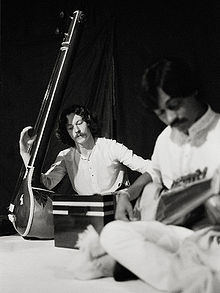- Tambura
-
This article is about the fretless drone lute. For the Eastern European saz, see tamburica. For the Greek long-neck lute, see tambouras. For river in Romania, see Tambura River. For the mountain in Italy, see Monte Tambura.
The tambura, tanpura, or tambora is a long-necked plucked lute (a stringed instrument found in different forms and in many places). The body shape of the tambura somewhat resembles that of the sitar, but it has no frets – only the open strings are played to accompany other musicians. It has four or five (rarely six) wire strings, which are plucked one after another in a regular pattern to create a harmonic resonance on the basic note (bourdon or drone function).
Tamburas come in different sizes and pitches: larger "males", smaller "females" for vocalists, and a yet smaller version is used for accompanying sitar or sarod, called tamburi or tanpuri. Male vocalists pitch their tonic note (Sa) to about C#; female singers usually a fifth higher. The male instrument has an open string length of approximately one metre, the female is three-fourths of the male. The standard tuning is 5-8-8-1 (sol do' do' do) or, in Indian sargam, PA-sa-sa-SA. For ragas that omit the fifth, the first string is tuned down to the natural fourth: 4-8-8-1 or Ma-sa-sa-Sa. Some ragas require a less common tuning with shuddh NI (one semitone below octave sa), NI-sa-sa-SA. With a five-string instrument, the seventh or NI (natural minor or major 7th) is added: PA-NI-sa-sa-SA (5-7-8-8-1 )or MA-NI-sa-sa-SA (4-7-8-8-1).
The name tanapura is probably derived from tana, referring to a musical phrase, and pura which means "full" or "complete". Both in its musical function and how it works, the tambura is unique in many ways. It does not partake in the melodic part of the music but it supports and sustains the melody by providing a colourful and dynamic harmonic resonance field based on one precise tone, the basic note or key-note.
The special overtone-rich sound is achieved by applying the principle of jivari, which creates a sustained "buzzing" sound in which particular harmonics will resonate with focused clarity. Jiva refers to "soul", that which gives life, implying that the tambura embodies an "animated" tone quality. The principle of jivari can be likened to the prismatic refraction of white light into the colours of the rainbow, as its acoustic twin principle at work.[citation needed]
To achieve this effect, the strings pass over a wide, arched bridge, the front of which slopes gently away from the surface of the strings. When a string is plucked, it has intermittent periodical contact with the bridge; this intermittent grazing of the string and bridge is not a static process, as the points of contact will gradually shift, being a compound function of amplitude, the curvature of the bridge, and string tension. When the string is plucked it has a large amplitude, moving up and down and contacting the bridge on the down-phase. As the energy of the string's movement gradually diminishes, the contact point of the string with the bridge slowly creeps up the slope to the top of the bridge, finally resting at the top of the bridge. Depending on scale and pitch, this can take between 3 and 10 seconds. This dynamic process can be fine-tuned using a cotton thread between string and bridge: by shifting the thread, the grazing contact is shifted to a different position on the bridge, changing the harmonic content. Every single string produces its own cascading range of harmonics and at the same time builds up a particular resonance. According to this principle tamburas are attentively tuned to achieve a particular tonal shade relative to the intonation-related qualities of the raga.
These more delicate aspects of tuning are directly related to what Indian musicians call raga svaroop, which is about how characteristic intonations strengthen the tonal impression of a particular raga. The tambura's particular setup, with its adjustable bridge, made it possible to explore a multitude of harmonic relations produced by the subtle harmonic interplay of four strings.
Tamburas are designed in three different styles:
- Miraj style: the favourite form of tanpura for Hindustani performers. It is usually between three to five feet in length, with a well-rounded resonator plate (tabli) and a long, hollow straight neck. The round lower chamber to which the tabli, the connecting heel-piece and the neck (dandh) are fixed is actually a selected and dried gourd (tumba). Wood used is either tun or teak, bridges are usually cut from one piece of bone.
- Tanjore style: this is a south Indian style of tambura, used widely by Carnatic music performers. It has a somewhat different shape and style of decoration from that of the Miraj, but is otherwise much the same size. Typically, no gourd is used, but the spherical part is gouged out of a solid block of wood. The neck is somewhat smaller in diameter. Jackwood is used throughout, bridges are usually cut from one piece of rosewood. Often two rosettes are drilled out and ornamented with inlaywork.
- Tamburi: small-scale instruments, used for accompanying instrumental soloists. It is two to three feet long, with a flat bed-pan type wooden body with a slightly curved tabli. It may have from four to six strings. Tamburi are tuned to the higher octave and are the preferred instruments for accompanying solo-performances by string-playing artists, as the lighter, more transparent sound does not drown out the lower register of a sitar, sarod, or sarangi.
References
Scheherezade Qassim Hassan, R. Conway Morris, John Baily, Jean During. "Tanbūr", The New Grove Dictionary of Music and Musicians, ed. S. Sadie and J. Tyrrell (London: Macmillan, 2001), xxv, pp. 61-62.
See also
External links
Categories:- Indian musical instruments
- Hindustani musical instruments
- Carnatic music instruments
- Necked bowl lutes
Wikimedia Foundation. 2010.


